A SamCart vs. Shopify comparison is a comparison between two e-commerce platforms that fulfill slightly different but nevertheless similar purposes. They have similar features and perform similar functions, but they meet somewhat different business needs and cater to different subcategories of e-commerce enthusiasts.
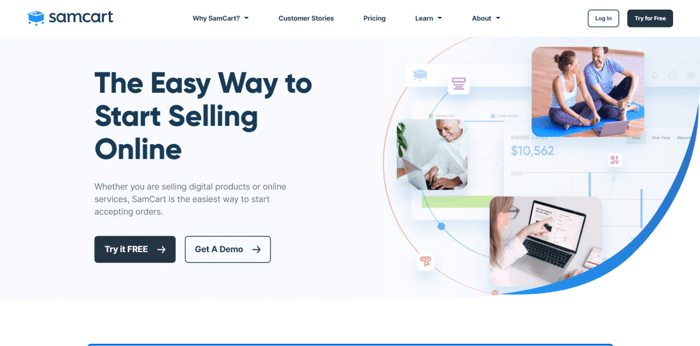
You can start an e-commerce venture on either one, but it will be different depending on whether it is Samcart or Shopify that powers your business. To avoid wasting precious time and making the wrong choice, you should learn as much as possible about these two platforms and be clear about what to expect before you opt for one or the other.
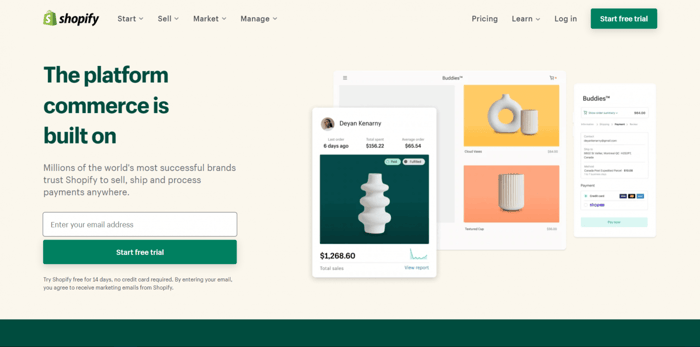
In this SamCart vs. Shopify guide, we’ll try to provide at least part of the most important information on the two e-commerce platforms. Hopefully, by the end of the article, you’ll know how they function, their main focus, key differences, and which one would be more suitable for your business venture.
Table of Contents
Who Is SamCart For?
Until relatively recently, SamCart was ideal for business owners who just wanted to have access to an excellent shopping cart without the overhead and hassle of building and running a full-fledged e-commerce store. The platform would let you build great sales pages/checkouts to promote and sell your products and services without having to create an e-commerce store.
Lately, things have started to change. Now, SamCart is more than just an excellent shopping cart or sales/checkout pages builder. As you’ll see in the following sections, in addition to the e-commerce features, SamCart offers features of other types as well, such as the ability to create and host courses and build membership sites on the platform. Nonetheless, as far as its e-commerce functions are concerned, SamCart hasn’t changed that much, which has certain corollaries.
Since SamCart offers you the possibility to create a sales page for every product you have but not the ability to build a store, it’s kinda assumed that you won’t be selling thousands of products on the platform. This implies that SamCart might not be the best solution for e-commerce businesses with large catalogs.
As many other reviewers agree, SamCart probably works best for selling one product or, at most, a couple of them. This is one of the key differences between SamCart and Shopify. The way it functions, the platform enables you to highlight that one special product of yours and make it look like the most important thing in the world. The best thing is that SamCart lets you do this without leaving the impression of being a pushy seller, which is ideal both from a seller’s and a buyer’s perspective.
Regardless of whether you want to monetize your blog, teaching skills, expert knowledge in a certain area, or your handiwork, you can take advantage of the SamCart e-commerce features. The fact that it allows users to create sales/checkout pages without building an online store makes SamCart suitable for just about anybody who wants to offer something for sale. More precisely, you’ll have the ability to create a page that lets you market and sell what you offer without even becoming a full-blown e-commerce entrepreneur and going deep into this field.
Who Is Shopify For?
On the other hand, if you’re determined to become a full-blown e-commerce entrepreneur, put in the hours and effort, and specialize in the e-commerce field, Shopify is a great fit. If you want and really need to open a complete (e-commerce) store that gives you a plethora of choice and tools, access to thousands of integrations, and control over virtually every aspect of your business – in terms of the ability to tinker with and configure virtually every detail of your storefront and online business – you should go for Shopify.
Based on that, Shopify is great for businesses that have many products to offer and stores with large catalogs. It’s a big e-commerce platform that will provide you with everything you need and then some to run your store as smoothly as possible. Even if you’re just starting out but firmly believe that an e-commerce store is a must for letting your business thrive online, Shopify has something in store for you.
Shopify is an e-commerce giant that has been quite innovative over the years. Soon after it started, it democratized the market and made everything e-commerce-related available and affordable for anyone. Its name has become almost synonymous with e-commerce and reliability, so if you’re looking for a long-term solution that allows businesses to scale, Shopify should definitely make your list of best candidates.
Pricing
For many business software solutions, there’s no way they can see big success if their prices exceed the purchasing power of most of the users. Undoubtedly, pricing plays a major role in the decision-making process of anyone looking for a viable e-commerce solution. That’s why, in this section, we’ll take a look at the SamCart and Shopify pricing plans and see what the platforms offer in this realm.
The SamCart Pricing
The SamCart pricing system includes three standard pricing plans, one enterprise plan, and a 14-day free trial.
The Standard SamCart Plans
The monthly fees for the three standard pricing plans are the following:
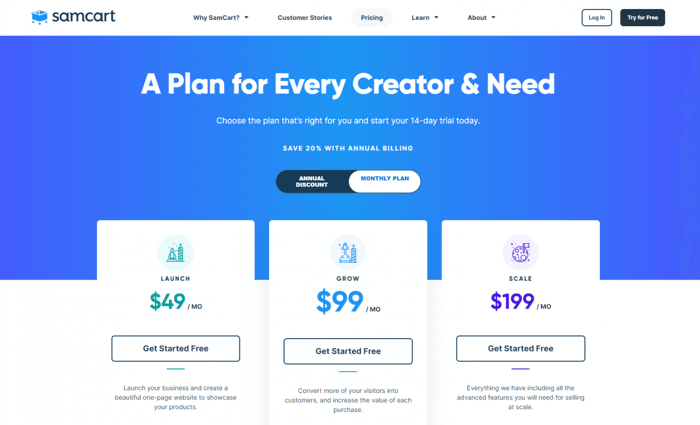
As with any other e-commerce platform, the annual billing includes a discount. In SamCart’s case, an annual subscription saves you 20% of the total amount you pay for a year of SamCart on a monthly plan. More precisely, with the annual subscription, you pay:
- $468 instead of $588 for a whole year on the Launch plan
- $948 instead of $1,188 for a whole year on the Grow plan
- $1,908 instead of $2,388 for a whole year on the Scale plan
Obviously, an annual subscription is the wiser choice, but only as a long-term solution. If for any reason you needed to cancel your subscription a few months in, it would end up being much more expensive since you can’t get a refund for the unused months. On the other hand, a monthly subscription allows you to cancel at any time you want without losing money. So, you should go for an annual subscription only if you’re sure that you’ll stay with SamCart for at least a year and are ready for long-term commitment.
The Enterprise Plan
The Enterprise plan is exactly what its name says: a SamCart offering that targets enterprise-level companies. This means that it includes features that make sense only in the context of a large business. Otherwise, you would neither need them nor really use them.
As for how much it costs, the Enterprise plan has a custom price. The fees you pay are probably determined depending on what exactly you need as well as the level of customization required by your specific business situation.
The Shopify Pricing
The Shopify pricing system consists of three standard pricing plans, one non-standard plan, and one enterprise plan. Shopify also offers a 14-day free trial.
If “standard” and “non-standard” are a little fuzzy right now, please bear with us. By the end of this subsection, it’ll be much clearer.
The Standard Shopify Plans
These are the three standard pricing plans paid monthly:
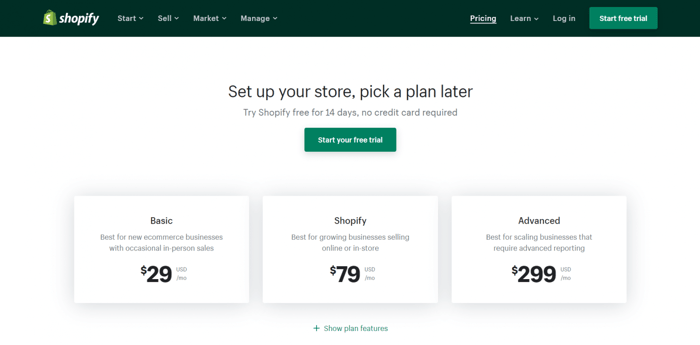
Clearly, price-wise, Shopify starts lower but ends higher than SamCart.
In addition to the monthly billing, Shopify offers two more billing options: annual and biannual. The first includes a 10% discount on all while the second offers 20% off on all three plans. The biannual option is the most economical, but it means a two-year commitment and an upfront payment of the full amount for two years of Shopify, which isn’t necessarily the most prudent decision.
Shopify Lite
Shopify Lite is the non-standard plan we mentioned earlier. Why did we refer to it with this term? Primarily, it’s because Shopify Lite doesn’t include the feature that Shopify is mostly known for: the ability to build an online store. It costs only $9/month and, based on the information available on the Shopify official site, it doesn’t seem to include an annual subscription option.
The two main things Shopify Lite does for e-commerce enthusiasts are the following:
- It allows businesses to use the Shopify Point-of-Sale Lite system to sell in person at events like fairs.
- It allows business owners to “add a Buy Button to their existing website.”
The Shopify Lite plan is for you if you have already built your business elsewhere. For instance, you might already have a website or blog where you promote your business, but you need a POS system to sell on-site and a Buy Button to sell online directly from your site/blog. That’s where Shopify Lite comes in.
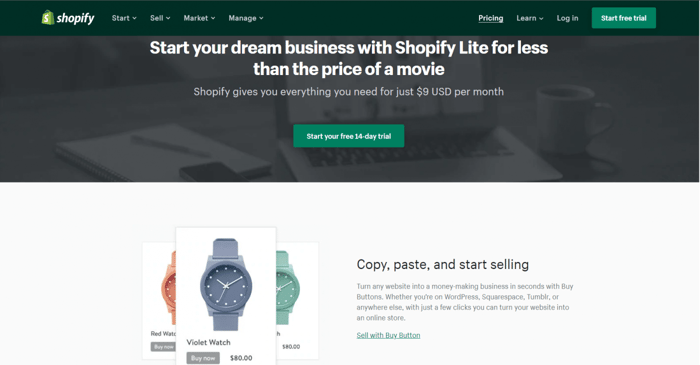
In short, Shopify Lite is a convenient way to sell both ways, online and on-site, without an online Shopify store. On top of this, it allows you to reap some of the other benefits that Shopify offers to its customers, such as gift cards, discount codes, order management, financial reports, etc.
Shopify Plus
Shopify Plus is the most expensive Shopify offering. The company calls Shopify Plus an enterprise platform, implying that it’s more than just a plan.

The lower limit for a Shopify Plus subscription is $2,000/month. However, since it’s basically a custom offering, the monthly fee can vary from case to case and may go significantly higher than this amount.
Many prominent brands’ and celebrities’ online stores are powered by Shopify Plus, some of the most widely known being Heinz, 2 Chainz, and Gymshark.
Plans, Features, and Affordability
For starters, let’s narrow down our discussion to just the three standard pricing plans on both platforms.
Just from looking at the features and prices of these plans, without going too in-depth, the first impression is that, overall, Shopify seems to be the more affordable option. Two of the plans are cheaper than the same-tier SamCart plans. The highest-tier Shopify Advanced plan is the only one that’s more expensive than its SamCart counterpart. Remember, that’s just prices we’re talking about here.
However, going over the plans’ features makes (hasty) conclusions much more complicated. Indeed, unlike SamCart, Shopify includes more staff accounts, an abandoned cart recovery option, inventory locations, and a POS system right from the lowest-tier plan and for a lower price.
Having said that, SamCart offers unlimited courses and memberships, which are not built into Shopify. You can install an integration like Courses, which has a free plan, but if you find the free plan unsatisfactory, a third-party app is just another cost on top of your regular Shopify fees. With this cost, you may end up paying the same sum or even more than in SamCart.
Regarding the highest-tier standard pricing plans, the Shopify Advanced plan includes so many advanced features, mainly closely related to running a large e-commerce store, such as:
- More staff accounts (than SamCart)
- Advanced reports
- Calculated third-party shipping rates
- USPS Priority mail Cubic pricing
- Custom pricing, etc.
On the other hand, it lacks built-in split-testing, which is a part of the SamCart Scale plan for a lower price, for instance. Anyway, the most important thing to realize is that you can’t really compare the pricing plans in this way and for a very simple reason: they’re built for different e-commerce ventures and entrepreneurs. SamCart is not exactly a Shopify alternative or vice versa.
So, once again, if you need an e-commerce store, go for Shopify. If it’s too expensive, try other more affordable platforms that offer the tools to create and run an e-commerce storefront. On the flip side, if you just need a convenient and sophisticated way to promote and sell your products/services, SamCart is your friend. If you think it’s too expensive for what it offers, as some users express in their reviews, you should try to find a more affordable alternative.
The Most Important Differences
Needless to say, here we’ll explore only a fraction of the complete list of differences between SamCart and Shopify. The few features we single out in this section show only some of the most fundamental differences between the two e-commerce platforms, as we covered many of their other distinctions already.
Checkout
In SamCart, the checkout is a part of the sales page. This means that users can find all the necessary information on the product they’re interested in, some form of social proof, and a checkout form on the same page. If it happens that they like what they see, they can fill out the form and make a purchase from the same page. This makes things much easier and more convenient for users who prefer not to go back and forth between pages.
In addition to this, SamCart allows you to add an upsell offer on the very same sales page, so you can increase your chances to maximize your sales. Equally important, since SamCart has specialized in this type of sales/checkout pages, it knows how to do them correctly to avoid overcrowding that can overwhelm and discourage users from completing a purchase. SamCart sales/checkout pages are generally quite simple and intuitive.
Transaction Fees
This is another thing that SamCart and Shopify differ in. While SamCart doesn’t include any transaction fees, Shopify does charge a transaction fee. However, keep in mind that these only apply to customers who don’t use Shopify’s own payment gateway – Shopify Payments.
If you thought that the higher-tier plans did not include this fee, we have to disappoint you. Shopify takes a (small) cut from your sales regardless of which one of the three standard plans you’re subscribed to. Currently, the transaction fees are the following:
- The Basic plan: 2.0% of your earnings per sale
- The Shopify plan: 1.5% of your earnings per sale
- The Advanced plan: 0.5% of your earnings per sale
Point-of-Sale
Shopify is one of the rare e-commerce companies that has its own native Point-of-Sale system (POS). We haven’t checked any relevant stats on this, but we think that it’s safe to assume that this tool has played a very prominent role in the company’s huge success.
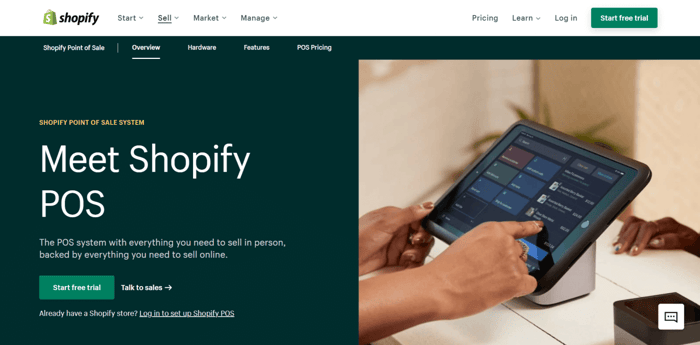
The Shopify POS is an extremely powerful tool that allows entrepreneurs to synchronize their e-commerce and brick-and-mortar stores, allowing them to sell online and on-site. Some of the Shopify POS features are the following:
- Offline cash payments
- Refunds
- Camera barcode scanning
- Email and SMS receipts
- Multi-location inventory, orders, and customer management
- Discount codes, etc.
Shopify offers two versions of its POS system: Lite and Pro. They share the features we enumerated above as well as many more others. In addition to the features they have in common, the Shopify POS Pro includes some unique and more advanced features, such as:
- In-app retail store analytics
- Local delivery and pickup fulfillment
- Daily sales reports
- Custom printed receipts
- Automatic discounts, and more.
The Shopify POS Pro comes out of the box only with Shopify Plus, while the Lite version is a part of all the other four plans. If you’re on any of the three standard plans but need the Shopify POS Pro, Shopify allows you to add it to your toolset for the additional charge of $89/month.
According to this Shopify Help Center entry, “Shopify POS Pro is billed either on a monthly or annual billing cycle.” What this means precisely, and for more on the specifics of the billing cycles, check out the link.
Shopify Payments
Shopify Payments is the platform’s built-in payment gateway based on Stripe. It’s available out of the box, which means that, unlike in SamCart, you don’t need to go through the usual process of connecting your Shopify account with Stripe or any other third-party payment provider. The only thing you need to take care of is to turn it on, and you’ll be able to enjoy the perks and reap the app's benefits.

However, here’s the trick: unfortunately, Shopify Payments is not available to users worldwide. You can activate Shopify Payments in only 17 countries, notably the United States, Australia, Canada, most countries from the EU, the UK, and a few more. For the complete list, take a look at the Shopify Payments requirements article published on the Shopify Help Center.
Some of the Shopify Payments features worth mentioning are the following:
- It’s PCI compliant.
- It allows you to accept payments made with Visa, MasterCard, American Express, Apple Pay, Google Pay, etc.
- It allows you to accept payments in multiple currencies.
- It allows you to track your payments and orders.
- It supports data encryption.
- It includes fraud analysis.
- It doesn’t include payment processing fees, etc.
Despite some of its limitations (like the small number of countries it’s available in), in addition to convenience, Shopify Payments has so many other advantages that should make it a no-brainer for any Shopify customer whose business meets the requirements.
Integrations
Regardless of how powerful, big, and good an e-commerce platform is, giving its customers the possibility to add more functionalities through integration is something that no software business solution can do without today. Some platforms offer thousands of integration options, others far fewer; as long as there’s a possibility to integrate a third-party app without serious issues or hiccups, we could say that an e-commerce platform has done its job well.
SamCart
On the SamCart Partners & Integrations page, you’ll find over 30 official partners and integrations. It’s not a big number, but those that are on the list are among the most popular names in the business world, such as ShipStation, WordPress, Thinkific, Zapier, PayPal, Mailchimp, ConvertKit, and HubSpot. Some of them help you with email marketing and automation; others allow you to process payments; a few make it possible to create pages and build membership sites. Last but not least, integrations like Zapier enable you to connect to a ton more apps.
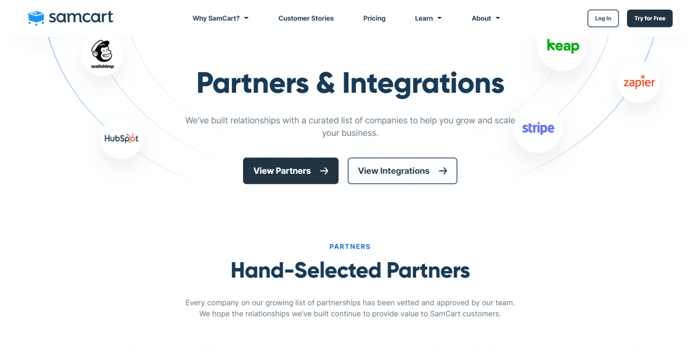
But the list of possible SamCart integrations doesn’t end here. Besides the official integrations, the platform allows you to add more software tools via HTML embed codes. For instance, SamCart lacks a blogging functionality, but many entrepreneurs would probably love to have access to a blog via their SamCart account. Today, brand building and marketing promotion through blogging have become common practices for online businesses.
Thanks to the possibility of adding a custom HTML block to its sales pages, you can integrate SamCart with DropInBlog and create a blog from your SamCart account. This integration method can open up a sea of other integration possibilities and turn SamCart into a much more flexible platform than it might seem at a glance, so we think that it’s really worth your time and effort to do some research and learn more about installing apps via custom HTML blocks.
Shopify
Shopify is definitely one of the best e-commerce platforms ever when it comes to integrations. It already offers hundreds, if not thousands, of high-quality integration options, and with developers working on more and more Shopify apps every day, this number is constantly growing. You would be really hard-pressed not to find whatever functionality you need.
The Shopify App Store is the place to search for integrations.
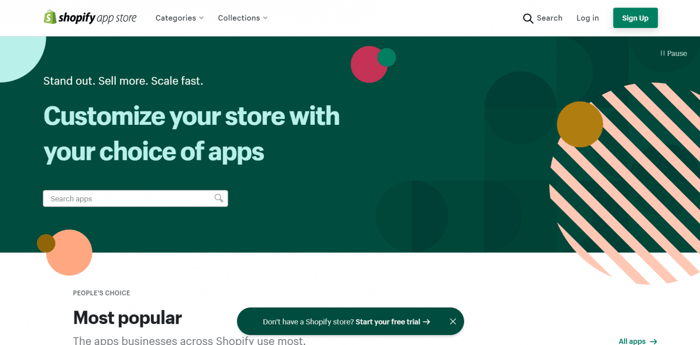
The Shopify App Store offers a ton of free and paid options sorted into nine categories and eight collections. The categories branch out into many subcategories that help you find more easily what you need in the shortest possible time. Collections have the same role of helping you out with your search, the difference from the categories being that categories are groups of apps sorted exclusively according to their purpose (marketing, conversion, fulfillment, shipping and delivery, etc.), while collections are groups of apps sorted based on multiple factors, some of which are the following three:
- The apps that work with Shopify native solutions like Shopify POS, Shopify Checkout, and Shopify Marketing.
- The apps made by Shopify.
- Top solutions in the email marketing area (due to email marketing playing one of the most important roles in the e-commerce businesses).
In addition to collections and categories, Shopify gives you a hand when choosing by showing you lists of apps that are:
- Most popular.
- In the spotlight lately.
- Suitable for different types of businesses.
- Made by proven app makers, and more.
Without a doubt, Shopify has a lot more to offer in the integration realm than SamCart. However, keep in mind that the latter is a much smaller company, so the much smaller number of integrations doesn’t come as a surprise. Besides, if you ask us, the smaller number of integrations is kind of perfectly in line with SamCart’s focused and, up to a point, minimalistic approach to e-commerce. In the end, which one you like is really a matter of preferences and/or real business needs.
Customer Support
SamCart
One of the best aspects of the SamCart customer support is that the company offers live chat human support. What we mean is that whenever you use chat support, you’ll be communicating with a Shopify support team member, not a chatbot. Although we can’t deny the merits of chatbots, communicating with one can, at times, be a frustrating experience and put really your patience to the test.
In addition to the live chat option, as you might have expected, SamCart offers email support as well. While the chat support team is available during the workweek from 9 a.m. to 5 p.m. ET, you can reach the SamCart email support team any time you need to. Just like the majority of the business software solutions, how quickly you’ll get answers will depend on your pricing plan. The higher-tier the plan, the quicker the response.
There are lots of other ways that SamCart helps and support its customers, some of which are:
- Onboarding and regular weekly webinars
- One-on-one launch support call
- Dedicated SamCart expert help
- Knowledge base
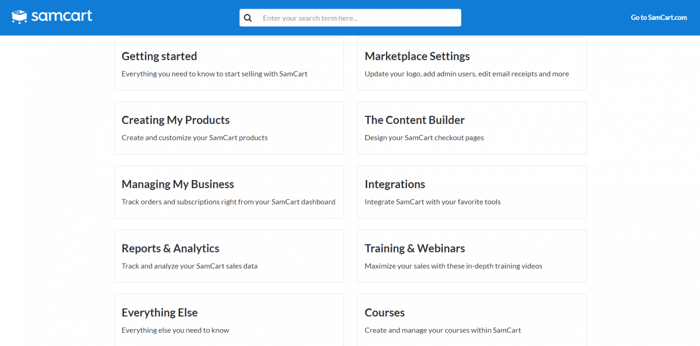
As far as customer satisfaction is concerned, SamCart fares pretty well in this domain. There aren’t as many reviews on SamCart as on Shopify and other popular e-commerce solutions, but those that you can find on specialized customer reviews websites like Capterra and G2 show overwhelmingly positive experiences with the platform’s customer support service.
Shopify
The biggest advantage of Shopify over SamCart in the customer support realm is that the first offers regular phone support. When we say regular, we mean available to all of its customers at any time (according to what this Shopify Community entry implies, it seems that the phone support is available 24/7), as opposed to just on isolated occasions (for instance, as a part of the onboarding process). The phone support works by requesting a callback, scheduling a call, and the support team calls you later.
As expected from the caliber of e-commerce company that Shopify is, there’s also around-the-clock chat and email support. In addition to this, Shopify customers can resolve many ambiguities and get answers to their questions through the official Shopify Community.
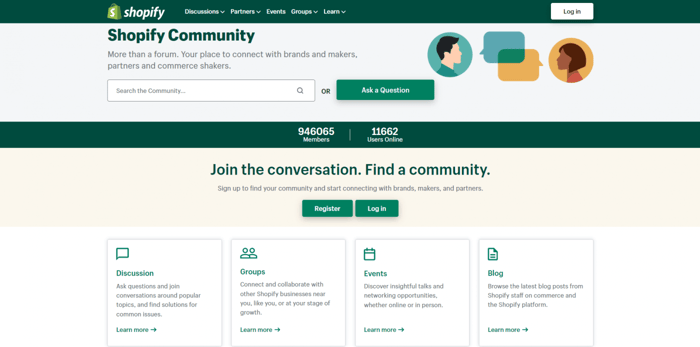
On top of all this, Shopify offers help via the platform’s official blog, the Shopify Help Center, Shopify Learn, its official social media accounts, etc.
As far as the quality of the support service it provides, based on much bigger reviews on G2 and Capterra (compared to SamCart), we can say that the company performs pretty well. The average grades are not as high as SamCart’s ratings. Still, taking into account that, in principle, it’s a bit harder to keep extremely high ratings as the number of customers and reviews grows (at least, that’s our opinion on the subject), just like SamCart, you can expect to get pretty good customer support service on Shopify as well.
Over and Out
Our SamCart vs. Shopify comparison touched only on some aspects of these two e-commerce platforms. There are so many other facets to explore – like how the Samcart page builder compares to the Shopify store builder, how the analytics tools compare against each other, how things stand in the email marketing realm, and many more. To encompass all of them, we might end up with a whole book.
We hope that this article succeeded in showing you what SamCart and Shopify really are, besides generic “e-commerce platforms,” and how you might best use each of them. Thank you for staying with us until the end, and we hope that it’ll be of some help on your own e-commerce journey.




